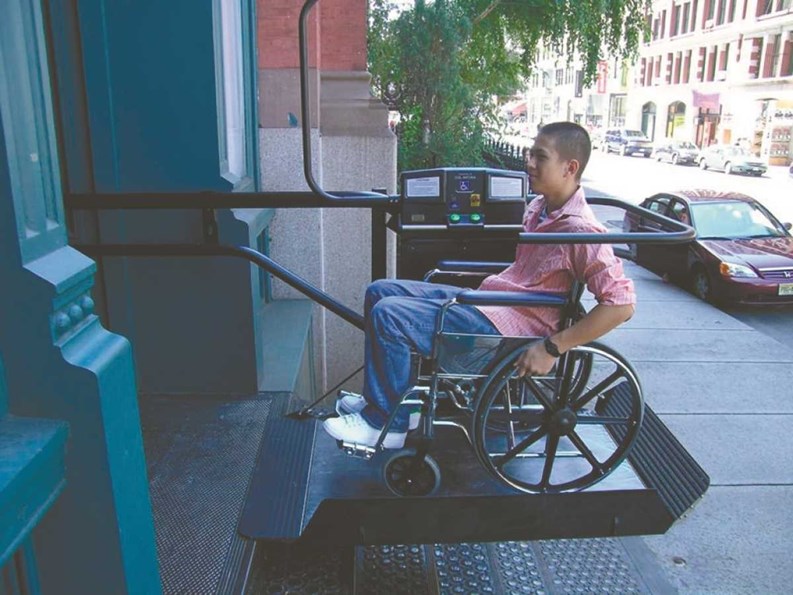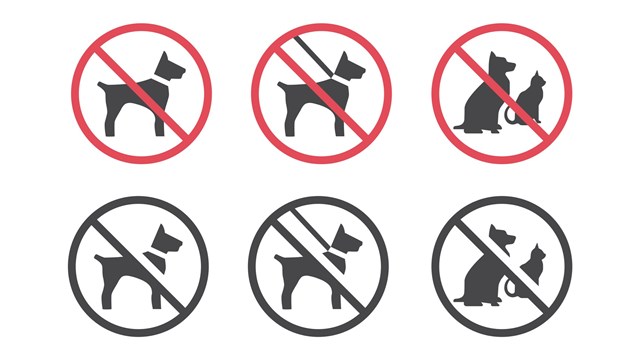New Yorkers are a resourceful bunch—we pride ourselves on being able to snag a cab during rush hour, get from the Upper West Side to Greenpoint in less than three subway transfers, and show no fear as we battle the crowd at a hot designer sample sale. For city residents with compromised mobility however, the ability to do tasks that many of us take for granted is profoundly impacted. For those with long-term disabilities, the elderly, or those recovering from an illness or injury, even getting into or out of their own building can feel like a monumental task.
To make day-to-day life easier, an array of laws have been enacted that provide protection and grant those with disabilities equal access to buildings and other public spaces. Central among those laws is Title III of the Americans with Disabilities Act of 1990 (ADA), which states that owners of certain buildings must eliminate barriers and provide people with disabilities with access equal to or similar to that available to the general public. Another cornerstone law is the city's Human Rights Law, administered by the New York City Commission on Human Rights (CCHR), which further protects the rights of people with disabilities by requiring that landlords and management of co-ops and condominiums reasonably accommodate the needs of disabled tenants, shareholders or owners.
What's Reasonable?
The CCHR’s Law Enforcement Bureau says that the biggest problem faced under the rules of the ADA is the belief that older buildings are grandfathered out of the law and thus not required to make changes. The goal of the bureau is to make sure that every building that can be made accessible in a reasonable fashion—if there is a unit owner that requires it—be made accessible.
'Reasonable accommodation' as it's used in the language of these two laws can be structural—such as a ramp at a building's primary entrance to provide wheelchair/walker access, or installing grab-bars in public/community bathrooms. Reasonable accommodation can also involve changes to rules or policies, such as permitting a disabled resident to keep a service or companion animal despite a building's “no pets” policy. The Human Rights Law provides guidance in assessing requests for reasonable accommodation, taking into account the nature and cost of the proposed accommodation and the financial resources of the landlord or building.
As is often the case however, knowing exactly how the ADA and Human Rights Law directly apply to a particular co-op or condo community can be complicated. Boards need to familiarize themselves, however—not fully understanding the laws‘ applications can result in accidental non-compliance, and that can lead not only to legal costs, but unnecessary acrimony between boards and residents. For example, managers and boards in the city's older buildings often assume—incorrectly —that the laws only apply to new construction, and therefore their prewar co-op is exempt. Others may be baffled by the technical requirements of these laws, and still others may assume—again, incorrectly—that making their buildng accessible will necessarily cost a fortune.
According to Joshua S.C. Parkhurst, a partner with the New York City-based law firm of Cary Kane, LLP, “The ADA provides a whole set of technical regulations regarding accessibility, the statute requires that the building be accessible for those with disabilities. There is a whole bevy of regulations as to what that means.” He points out that these regulations are why, “generally you'll see many buildings now with ramps and other accommodations for those with accessibility issues.”
Of course, one of the biggest questions on the minds of building managers and boards is how far the law requires them to go in order to make their property accessible? What exactly constitutes 'reasonable access?' According to Parkhurst, “The statute itself is broad, but the accessibility guidelines do provide a lot of specifics, and must be reviewed very carefully. The guidelines regulate even the placement of ATMs, saunas, steam rooms, laundry rooms, and their goal is to make it so that most people with disabilities are able to utilize the facilities of the building.”
Though these guidelines are in place to insure accessibility, that doesn't necessarily mean that a building must undertake massive renovations to meet the requirements of the statute. “Generally there is no need to change the building as existing,” says Parkhurst, “but once alterations are being made they then have to make them so that the building is accessible.”
David J. Byrne, an attorney with the law firm of Herrick, Feinstein LLP, agrees, “Generally speaking, the ADA is relevant in the condominium/co-op context in only the rehabilitation and/or renovation of existing facilities, etc., and only to the extent that said rehabilitation and/or renovation is of a certain significance.” Byrne goes on to say that “The ADA certainly is relevant to the creation of a new building. The United States Fair Housing Act (and any relevant city and/or state anti-discrimination codes) is typically more relevant regarding new construction.”
The key word here is renovation, says Parkhurst. “If you have a building that's not completely accessible,” he says, “and you are making changes to the front entrance in any regard, that's when you have to put the ramp in. When it comes to reasonable accommodation, a good rule of thumb is that when you’re making changes to something – any addition, any alteration - you've got to change it in a way that it will then be ADA compliant."
“What some people might consider regular maintenance,” Parkhurst adds, “may in fact trigger the alteration. For example, if the stairs to your entrance need repair, unless it's a real tiny patch-up job, there's a very good chance that it will trigger ADA and you'll need to meet the accessibility requirements, to the point that once you have to make the alteration or the addition, you must take advantage of that to include accessibility, even though sometimes making it accessible might become a project on top of what you were planning on doing.”
According to the city’s Human Rights law, disabled residents who need accommodation should inform the building manager and identify the type of accommodation needed. A note from a medical doctor or other health care professional may also be required, but medical records are not necessarily required. To help make the process smoother, there are several city-based organizations and offices where residents, management and boards can turn to for assistance and help in complying with the ADA. The CCHR’s Law Enforcement Bureau and the Mayor's Office for People with Disabilities are excellent places to start.
Non-Compliance? What Happens?
In spite of the fact that there are specific federal and state laws mandating equal or equivalent disabled access, some managers and building owners balk at making required exterior alterations for disabled residents, leading to dissatisfied unit owners, bitter litigation and hefty fines.
The CCHR’s Law Enforcement Bureau tries to intervene first in such situations, without resorting to formal complaints and litigation. The bureau's position is that the resident requiring accommodation be given it as quickly as possible, so bureau administrators try to reach out to the building management, owner or board and move the process along.
In doing this, the bureau officially reviews the case to verify the resident's need, and to determine whether the requested accommodation is reasonable on a financial or physical level for the building to make. The mayor's office can grant waivers to buildings and boards when a request for accessibility alterations outstrips what the building is able to provide, either structurally or financially. Parkhurst gives an example of such a case. “If you have a prewar walk-up, and a disabled person comes and says that they want to purchase the top apartment, you don't have to completely gut the building to put in an elevator.” That would be unreasonable—both physically and financially.
If the accommodation is determined to be reasonable and the building management and/or board refuse to comply with the Mayor's Office for People with Disabilities, the case is then referred to the CCHR. Those who refuse a hearing before the CCHR will have a complaint filed against them. The building, owner, or board will then have 30 days to comply, or an investigation will be initiated.
In the rare event that a request continues to be refused, the case may be sent to the Department of Justice (DOJ), which relies on a group known as the Key Bridge Foundation to mediate a solution. The foundation is a non-profit organization underwritten by the DOJ and specifically organized to handle complaints filed with the DOJ under Title III of the ADA.
According to the DOJ website, courts may levy civil penalties only in cases brought by the DOJ—not by private litigants. The department only seeks such penalties when the violation is substantial and the business (such as a co-op corporation or condominium association) has shown bad faith. This can take many forms, including hostile acts against people with disabilities, a long-term failure to inquire about what the ADA requires, or sustained resistance to voluntary compliance.
Get Accessible
James Boydston, the president of Handi-Lift, a company based in Carlstadt, New Jersey, that makes accessibility aids for disabled individuals throughout the tri-state area, sees many situations where managers and boards approach his company because a unit owner and the building are at the brink of a lawsuit over an accessibility issue.
“Many condos and co-ops have historical buildings that they don't want to change the look of, or install anything permanent in,” says Boydston, “so we are asked to make temporary accommodations, such as portable wheelchair lifts.” However, Boydston says that these products are a temporary answer, as they do not meet ADA requirements. “The ADA wants the wheelchair unit owner to be able to get in and out without assistance.”
According to the pros, as more Baby-Boomers age and require accommodations in order to fully enjoy their homes and common areas, ADA compliance may soon become a non-issue, simply because it will be a given. The demand for accessible housing will only increase over time, and built-in ADA-compliant features will be attractive marketing tools to a 55-and over population.
Moreover, making sure that buildings and common areas are accessible to all is more than just the legally required thing to do—it's the right thing to do, and doing it shows residents and their guests that they are both welcomed and valued.
Hannah Fons is an associate editor at The Cooperator.










Comments
Leave a Comment